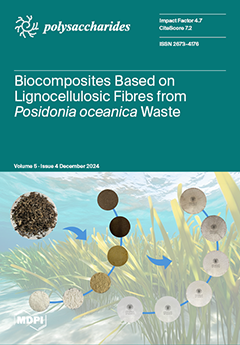Numerous bacterial species can both suppress plant pathogens and promote plant growth. By combining these bacteria with stabilizing substances, we can develop biological products with an extended shelf life, contributing to sustainable agriculture.
Bacillus subtilis is one such bacterial species, possessing traits that
[...] Read more.
Numerous bacterial species can both suppress plant pathogens and promote plant growth. By combining these bacteria with stabilizing substances, we can develop biological products with an extended shelf life, contributing to sustainable agriculture.
Bacillus subtilis is one such bacterial species, possessing traits that enhance plant growth and offer effective protection, making it suitable for various applications. In this study, we successfully incorporated
B. subtilis into hybrid materials composed of poly(3-hydroxybutyrate) (PHB) fibers coated with chitosan film. The polymer carrier not only supports the normal growth of the bioagent but also preserves its viability during long-term storage. For that reason, the impact of chitosan molecular weight on the dynamic viscosity of the solutions used for film formation, as well as the resulting film’s morphology, mechanical properties, and quantity of incorporated
B. subtilis, along with their growth dynamics was investigated. SEM was used to examine the morphology of
B. subtilis, electrospun PHB, and PHB mats coated with chitosan/
B. subtilis. The results from mechanical tests demonstrate that chitosan film formation enhanced the tensile strength of the tested materials. Microbiological tests confirmed that the bacteria incorporated into the hybrid materials grow normally. The conducted viability tests demonstrate that the bacteria incorporated within the electrospun materials remained viable both after incorporation and following 90 days of storage. Moreover, the prepared biohybrid materials effectively inhibited the growth of the plant pathogenic strain
Alternaria. Thus, the study provides more efficient and sustainable agricultural solutions by reducing reliance on synthetic materials and enhancing environmental compatibility through the development of advanced biomaterials capable of delivering active biocontrol agents.
Full article





